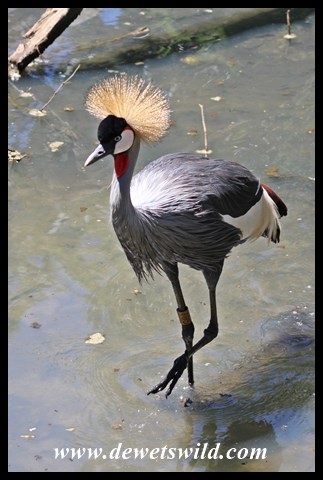Balearica regulorum
The Grey Crowned Crane with its eye-catching “hairstyle” must be one of the most easily identifiable birds in South Africa. Their Afrikaans name, Mahem, is a good imitation of their call. They stand about 1m high and weigh roughly 3.5kg.
Grey Crowned Cranes can be found in or near wetlands and flooded grasslands, and is one of the few crane species that will perch in trees. Their diet is omnivorous, ranging from grass-seeds and grains to insects, crabs and small vertebrates. Pairs are territorial during the nesting season, which stretches over the wetter seasons in South Africa. Nests are platforms built from grass and sedges in waterlogged areas. Courtship includes elaborate dances involving jumping and bowing. Two to five eggs are incubated for four weeks, and the precocial chicks fledge within 100 days of hatching. Outside the breeding season Grey Crowned Cranes flock and roost communally in groups numbering up to 200.
As a result of wide-spread habitat loss and illegal collection of eggs and live birds from the wild for the illegal wildlife trade and traditional uses, the IUCN considers the Grey Crowned Crane to be endangered, despite their wide distribution in Eastern, Central and Southern Africa. The population in South Africa is estimated at between 4,000 and 5,000 (out of a total population probably below 64,000 on the continent) and is mostly found in the provinces of the Eastern Cape, Kwazulu Natal, Free State and Mpumalanga.














Pingback: Exploring Golden Gate | de Wets Wild
Oh! It’s beautiful. Have a great week!
Marianne
LikeLike
And to you, thank you, Marianne!
LikeLiked by 1 person
Dis regtig n statige voël. Ek het nie geweet dat Mahem n afrikaanse benaming is nie. Ek ken hom ook as Mahem. Baie interessant. Ai die mensdom kan maar net nie stop om uit te brei nie en te vernietig nie.
LikeLiked by 1 person
Dit sal n vreeslike jammerte wees as ons hulle verdryf…
LikeLike
Beslis ja! 😦
LikeLike
What a beautiful bird!
LikeLiked by 1 person
They really are splendid, Terry!
LikeLike
Pragtig!
LikeLiked by 1 person
Hulle is asemrowend, ne Tina!?
LikeLiked by 1 person
Money.
And our big, fat, human egos is what will kill everything and us stoopid, hairless apes in the end.
(End on a happy note…)
Lovely photos! They are such stately birds. Love the headdress 👑
LikeLiked by 1 person
Very regal birds, that’s for sure! If human greed forces them to extinction it would be such a sad day.
LikeLiked by 1 person
Would hate to see that beautiful bird disappear.
LikeLiked by 1 person
As would we, Kathy. Already they are a very rare sight and any encounter is a special treat.
LikeLike
(Skryf in Engels dat almal kan verstaan) … I live in an area where tourism is one of two major industries, the other being pine plantations. It is therefore a big employer. It’s a question of choosing between people and the fauna and flora. I recently attended a ‘Road Show’ of a tourism drive. Lodge owners are advised to create extra activities for people – resulting in gouging out bits of mountain for a toboggan slides, quad bikes, helicopter tours where they fly low into a gorge, creating unbelievable noise and pollution, water related activities and many more to attract even more tourists. No environmental checks are done prior to creating these activities. Extra roads are planned, parking lots made and on and on and on.
If I could find a way of curbing tourism, I would. I’m up against billions of Rand.
It’s the saddest thing.
LikeLiked by 2 people
Thanks Petru. Indeed, irresponsible tourism development can be just as devastating for wildlife as mining, farming, plantations etc.
LikeLike
Once again, you break our hearts with the population stats for this species.
LikeLiked by 2 people
Hopefully every bit of awareness will make a difference in the long run.
LikeLiked by 1 person
Quite the fancy pants of a Bird!! Beautiful! 🙂 T.
LikeLiked by 1 person
Real show-offs!
LikeLike
Wat is sy naam in Afrikaans?
LikeLike
Mahem, Toortsie – dit is n na-aping van hul roep.
LikeLiked by 1 person
Dankie
LikeLiked by 1 person
Dis so ‘n koninklike voël en weereens vraatsige mense,wat hom bedreig!Pragtige foto’s,Dries.
LikeLiked by 1 person
Sekerlik een van die aanskoulikste voëls op die planeet!
LikeLiked by 1 person
Why oh why can’t people let nature alone? I love what you write but it has to be frustrating for all the illegal activities that go one within the animal kingdom.
LikeLiked by 2 people
I can’t get my head around it either, Lois. Money, money, money…
LikeLiked by 1 person